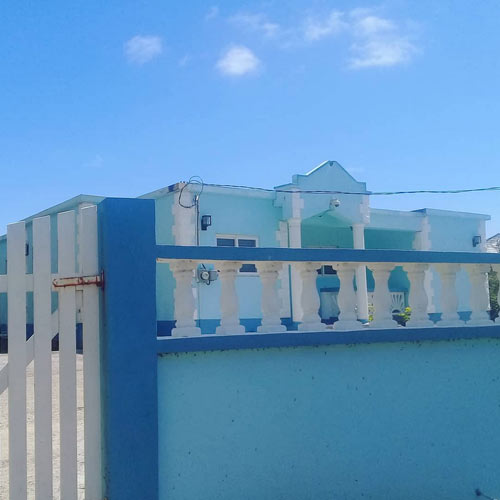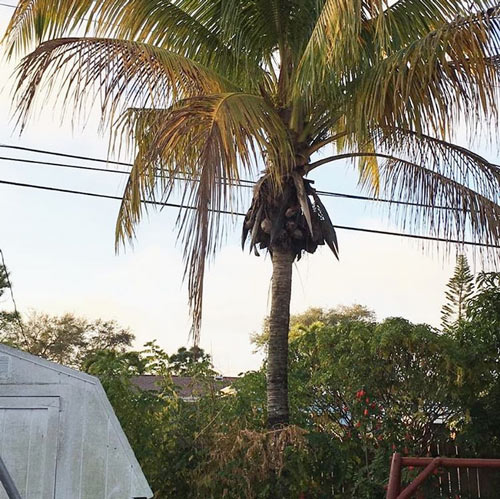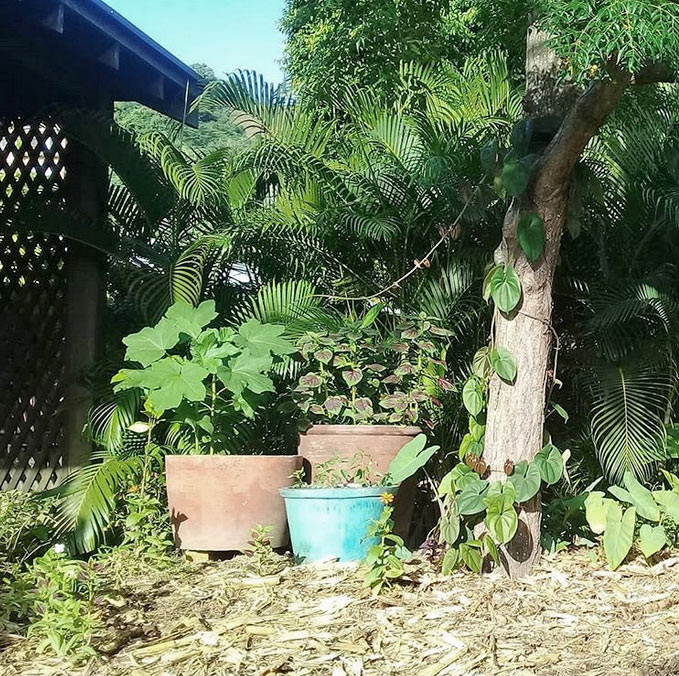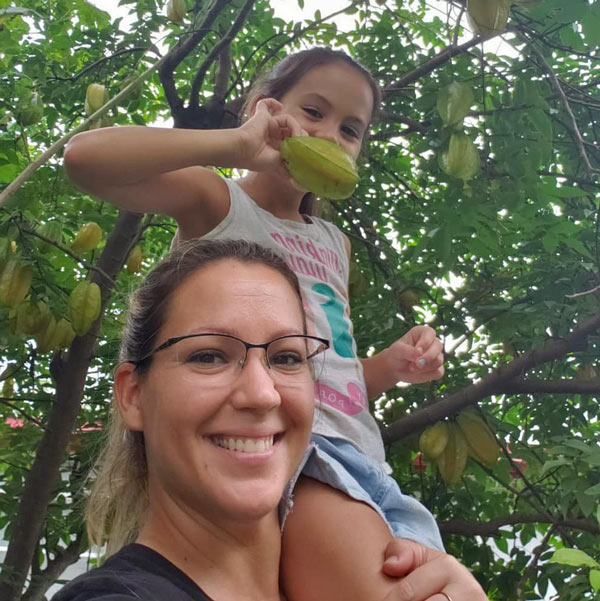How much land does it take to feed yourself?
We took a look at that question in a previous post and the frustrating answer was: it varies.
You May Also Enjoy: “How Much Land Do You Need to Feed Yourself?”
Today we’ll take a look at one particular region—the subtropics—and sketch out a theoretical plan for self-sufficiency on a small acreage. For purposes of specificity, let’s nail it down to one geographic region: South Florida. This is a climate in which I’ve done plenty of experimentation and have a good idea of what it takes to grow lots of calories in a limited space.
Are you ready? Let’s go!
A Hypothetical Case Study: 1964 Goldwater Rd., Hollywood, FL
Imagine a 1,200 square foot suburban 3/2 in Hollywood, FL. The complete footprint of the land is about 7,000 square feet, and the zoning is residential. You have neighbors on both sides and in the back, with a street in front of your house. Once the driveway, back patio, sidewalk, and footprint of the home are accounted for, you’re left with a little over 4,000 square feet of growing space.
Can you feed yourself completely? Or, to go more extreme: could you feed yourself, plus your wife, plus three children?
If possible at all, it’s going to take some serious planning and hard work. Hollywood is basically in the tropics, after all, so growing year-round is easy—and we’re going to have to do so to stay fed.
Your first assignment: put up a privacy fence around as much of your yard as is allowed by local statues. This means probably just the back. Hollywood is filled with idiot bureaucrats who love enforcing the status quo. That means they like lawns. Don’t let them get you—the front yard can be a place for food, but you have to be careful. Deal with the back yard first. Fence it in, then start planting. We’ll deal with the front yard later.
Start With Calories!
The average person needs 2,000 calories a day to survive. My go-to plant as a tropical survival staple is cassava. In South Florida, you can grow it year-round. The plants take about 9 months to make good roots. A family of four can live off the harvest from one plant for about two days. That means if you planted roughly 150 plants, at the 9-month point, you could start harvesting, then replanting as you do so. Since they don’t need to be harvested all at once and can sit in the ground for years, the food bank potential is amazing. At about 4′ x 4′ needed for each plant, you could do this on 2,400 square feet, consuming most or all of your backyard.
Obviously, you wouldn’t want to live on just cassava, but it puts a floor under your day-to-day calorie needs. Also, the yields get even better if you intercrop other species, since living on cassava would get tiresome and you’ll get fat from all the starch.
To mix it up, I’d stick poles all over the place, way up into the air between the cassava plants, or add nice airy trees like moringa (which also provide you with a remarkable amount of nutrition).
Then, I’d plant lots of climbing edibles like snake beans, bitter gourds (which are edible and medicinal), perennial cucumbers, yams (not sweet potatoes—we’re talking massive African yams), chayote, passion fruit, etc.
You May Also Enjoy:
The Wonderful Winged Yam: Demonized Invasive or Prolific Staple?
This should effectively double the yield of your cassava patch, though you’ll have to machete paths through and prune and plant as needed. Wider spacing on your patch, or small clearings, might also be a good idea to get sunlight through. In addition, cassava leaves are edible boiled, so you’ve got another veggie right there.
Continue With Nutrition!
Now that you’ve started with cassava, it’s time to move on to longer-term edibles. Around every edge of my yard and along each wall I’d plant tree and berry crops in tight spacings. Plantains and bananas are good starch/fruit plants, so add a good patch of those—and grow vines on them, too. For extra nutrition, it would be good to grow Surinam cherries, grumichama, acerola cherries, and at least one or two mulberry trees that you’d keep pruned so they don’t steal too much sun.
You May Also Enjoy: “Maintenance Pruning Mulberry Trees”
Packing in one or two jaboticaba trees would be another great idea, since they yield fruit 5–6 times a year once mature, plus they don’t get all that big.
But wait!
No yard in Hollywood would be complete without a few coconut palms. Coconuts are easy as heck to grow and take up very little space since they grow up in a nice column. I planted this one 25 years ago in my parents’ yard:
Put them here and there. The nutmeats are good food and the milk is great for your health.
Avocadoes, though tempting, might not be a good choice because of your limited space and their poor storage ability—but if at all possible, I’d add one, along with a mango—and if I really wanted to feel like a rich man, a macadamia nut tree … but that can get big, so you might have to practice extreme pruning or plant it on a friendly neighbor’s property.
Now your yard has big swaths of cassava, surrounded by a ring of fruit and berry bushes. Vines are growing everywhere and you can barely see the house. At this point, it’s time to look for little sunny spots where you can cram in sweet potatoes. In the tropics, sweet potatoes are perennials—and they grow like weeds. Is there sunlight along the edge of the patio? A patch between cassava? Plant these and let them run. Not only are sweet potatoes packed with nutrition, they’re highly productive—and the leaves are a valuable vegetable.
You May Also Enjoy:
“Sprouting Avocado Pits the Easy Way”
“Growing Bananas and Other Tropical Delights Beyond the Tropics”
One other plant that’s a must-have is the papaya. In South Florida, papaya are plagued by the papaya fruit fly, which lays eggs inside the developing fruit; however, you can cover them after the bloom drops to protect your harvest. Papaya are easy to start from seed and will self-perpetuate if you throw seeds around. From seed to harvest takes about 12 months, and the papaya will usually produce for a few years before needing replacement.
If there were another blank spot available after all that, I’d tuck in some chaya for its edible and nutritious greens, and a patch of katuk for the same.
Feed the System
Think your backyard is full now? Just wait! There’s more! You’ll want to add some support plants for soil feeding, for attracting insects, and for nitrogen fixing. In South Florida, most of the fertility of the soil is taken up into plants. Cut down all the plants and cart away the “refuse” and you get weedy, sandy patches of sun-baked wilderness. Let things rot in place, and the system keeps going pretty happily. Making nutritious anaerobic compost teas will also make a big difference on fertility and yields.
Up north, permaculturalists are big fans of comfrey. It makes a great “chop n’ drop” plant, compost additive, and liquid fertilizer ingredient. However, when you go south into Florida, comfrey is no longer the tough biomass-producing powerhouse it is further North. It suffers in the bright sun and fails to grow particularly well. So—down south—you’re going to look for other plants to feed the ground. One particularly good candidate is Tithonia diversifolia, also known as the “Mexican sunflower” or the “tree marigold.”
This fast-growing perennial member of the sunflower family can surpass 12′ in height and produces plenty of biomass. Cram them in here and there, chop back brutally when they start stealing too much sun from their neighbors, then drop the leaves and stems on the ground between other plants. Tithonia diversifolia is a great nutrient accumulator—let it do the hard work of searching for nutrients, then throw it around whatever you’d like to feed. Other plants worth adding are members of the Leucana family, since they fix nitrogen, pigeon peas (for nitrogen and edible peas), and various flowers to draw in more insect life. Moringa trees are also very good for using as chop and drop.
Another good idea: add some rock piles, brush, old logs, and other debris here and there to give lizards, snakes, insects, and other creatures a place to live. If you can put in a small pond, even better. Add extra food production to the pond by planting it with water chestnuts. Those are easy and produce piles of edible roots. Water spinach (Ipomoea aquatica) is another good water plant that produces masses of edible leaves.
Now you’ve created a pretty nice ecosystem. Between cassava, fruits, beans, cukes, and other crops, you’re also doing pretty good on calories. But what about protein and fat? Both or those are hard to find in the plant kingdom, yet they make life much better, particularly if you’re working your muscles.
Once I had my agricultural system operational and at a certain level of maturity, I’d start running a few hens through selected portions of the backyard jungle. If you’ve been dropping leaves and branches around, the hens will be totally happy to turn things over and find insects. Plus, you’ll likely be able to feed them on the surplus from your roots, fruits, and leaf crops. On such a small lot, I wouldn’t keep more than three or four birds; though it may be that once your system reaches a certain level of maturity, you could add more. I would also trade as many of my roots and veggies for meat as I could.
The Front Yard
Finally, it’s time to turn your attention to the front yard. Here’s where things get tricky.
They like grass in Hollywood. However, there are state laws that allow for growing landscapes that consume fewer resources than a lawn does. Use them to your advantage.
Though it’s tempting to tear up all the grass and tell everyone to take a hike, some ninny with power might nail us if we do that. So we’ll start this way: we’ll plant a few edible trees. This might be where you put your mango, avocado, or even macadamia tree. Those are pretty, they add shade, and they don’t look like “agriculture.”
Other good options include starfruit, the black sapote (also known as chocolate pudding fruit), lychee, canistel, or even a jackfruit.
You could also add more palms, since you can never have enough coconuts. Around the base of those trees, we take the lawn out in a nice, non-threatening circle, bordered by something pretty, like blocks or lime rock and conch shells or whatever looks good and is cheap. Then we put down mulch and start planting other edible and medicinal species. Aloe is a good choice, as are sage, lemon grass, cannas (which have edible roots and blooms), and, again, sweet potato. Sweet potatoes look like a vining ground cover. No one would complain about a nice patch of them inside a border since they look intentional. Potted plants can also look intentional.
Okinawa spinach is another attractive edible that makes excellent salads. Another good front-yard plant is the malanga. Those look like elephant ears but have delicious edible roots. You could also tuck in some sugar cane, which grows easily and has a bamboo-like tropical beauty.
One other plant I would add: coffee! That’s a wonderful and attractive plant that no one is going to recognize. Processing and roasting beans is a pain, but hey, after a day or two of caffeine deprivation post-TEOTWAWKI, you’ll figure something out.
As the canopy fills out in your front yard, you may be able to continue expanding your borders until attractive plants and mulch have completely replaced the lawn. Just don’t leave bare ground or let things get too messy. People are weird in the city. (Trust me—been there, done that, got the citation.)
If you attacked a yard in this manner, would you be completely self-sufficient? I believe the answer is yes. In fact, I’m working on a tropical food-producing system at a house much like the one I’m describing.
Check out my tour video here:
Even without a lot of care, the system is making plenty of food. And trees I planted years ago are now feeding my extended family—including my adorable nieces.
It wouldn’t be easy to be fully self-sufficient, and you’re going to have to work on stacking species to take the most advantage of sunlight and rainfall, but the possibilities are ripe for exploration (and we haven’t even taken a look at what you could do if you lined the driveway with planting containers, strung lines from tree to tree for vines, raised tilapia, hung pots down the sides of trees, planted in gutters, or let vines cover the roof).
There’s no good reason why a region without freezes and with plenty of rainfall couldn’t be completely self-feeding, rather than relying on imported food from thousands of miles away. The problem is a lack of imagination, oppressive codes, neighbors who don’t “get it,” and homeowners who know nothing but grass and hedges.
Be bold and embrace the challenge!
David The Good is a Grow Network Change Maker, a gardening expert, and the author of five books you can find on Amazon: Compost Everything: The Good Guide to Extreme Composting, Grow or Die: The Good Guide to Survival Gardening, Totally Crazy Easy Florida Gardening, Create Your Own Florida Food Forest, and Push the Zone: The Good Guide to Growing Tropical Plants Beyond the Tropics. Find fresh gardening inspiration at his website TheSurvivalGardener.com and be sure to follow his popular YouTube channel.











COMMENTS(2)
Thank you for the post, David. It was enjoyable to read about the journey of being creative and planning the suburban garden. Needless to say its always a challenge when living in an urban townhome with restrictive Deed(HOA) but I always see how far I can push the mini-garden we have here in Houston, Texas. It was a very encouraging study.
Some really great ideas! The rules imposed by some communities are rather strict.
Having lived in tropical South America for many years, guava trees and pineapple are also possibilities. Guava has medicinal properties as well. Papaya needs a male and female to produce fruit so yes several seeds must be sown but not too far apart. If planting a banana shoot, it needs to be planted near a pond or water source. It likes wet feet.
Great caution must be taken regarding cassava as some varieties are poisonous. They are still edible but certain procedures must be followed. The leaves for example must be boiled for 7 days ! The process of preparation for the root is quite labor intensive and time consuming to remove the poison. Briefly, after peeling, the root is grated and squeezed. The pulp is left to dry and the juice left to sit. A white powdery substance will settle in the juice after a day, that is tapioca. The juice can be used but of course but must be boiled. The tapioca must be rinsed several times which takes several days. The dried pulp is grilled and can be ground into flour. It is not a substitute for wheat flour at all. Since is very hard and dry (caution to those with dental work), it is usually sprinkled on meat sauces or made into “farofa”. By itself, cassava has little nutritional value but it does fill you up. It can be used medicinally as well for diarrhea when cooked with water to make like a syrup with salt and sugar added.
The non-poisonous variety is usually peeled and cut into cubes as it is quite fibrous, boiled and eaten with butter and salt. Mashed, it has the consistency of sticky oatmeal. it can also be used to make a “cake”.
Coconut water on the other hand, is extremely nutritious and probably THE most important for survival. It is better to use the young fruit and not the fully mature ones. Making your own coconut milk requires a fairly heavy duty blender.